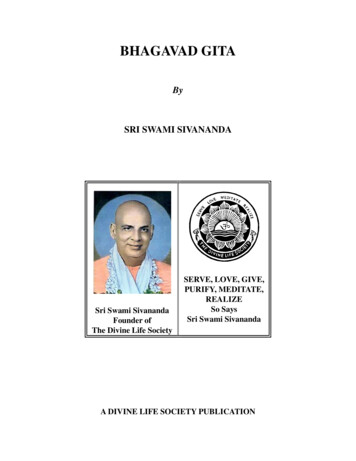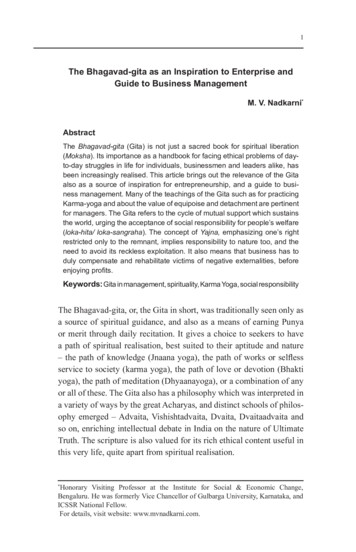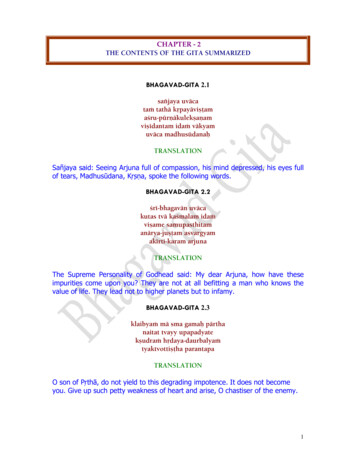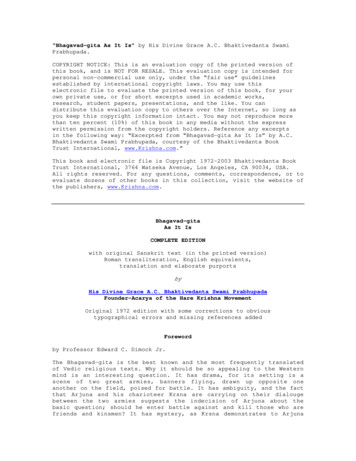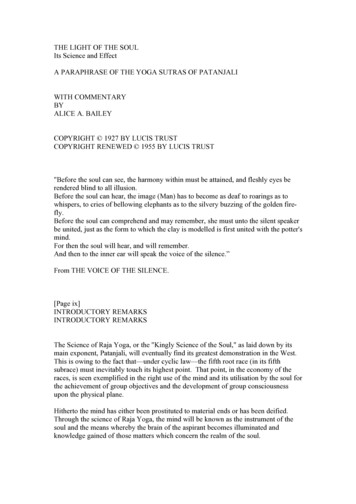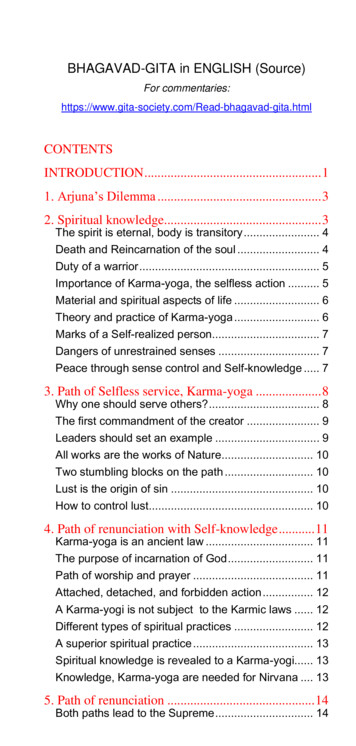
Transcription
BHAGAVAD-GITA in ENGLISH (Source)For gavad-gita.htmlCONTENTSINTRODUCTION . 11. Arjuna’s Dilemma . 32. Spiritual knowledge. 3The spirit is eternal, body is transitory . 4Death and Reincarnation of the soul . 4Duty of a warrior . 5Importance of Karma-yoga, the selfless action . 5Material and spiritual aspects of life . 6Theory and practice of Karma-yoga . 6Marks of a Self-realized person. 7Dangers of unrestrained senses . 7Peace through sense control and Self-knowledge . 73. Path of Selfless service, Karma-yoga . 8Why one should serve others? . 8The first commandment of the creator . 9Leaders should set an example . 9All works are the works of Nature . 10Two stumbling blocks on the path . 10Lust is the origin of sin . 10How to control lust . 104. Path of renunciation with Self-knowledge . 11Karma-yoga is an ancient law . 11The purpose of incarnation of God . 11Path of worship and prayer . 11Attached, detached, and forbidden action . 12A Karma-yogi is not subject to the Karmic laws . 12Different types of spiritual practices . 12A superior spiritual practice . 13Spiritual knowledge is revealed to a Karma-yogi. 13Knowledge, Karma-yoga are needed for Nirvana . 135. Path of renunciation . 14Both paths lead to the Supreme . 14
2International Gita SocietyA Karma-yogi works for God only. 14The path of Self-knowledge. 14Additional marks of an enlightened person . 15Path of meditation and contemplation . 156. Path of meditation . 16A Karma-yogi is also a renunciant . 16A definition of yoga and yogi . 16Mind is both a friend and an enemy . 16Techniques of meditation . 16Who is a yogi?. 17Two methods to subdue the mind . 18Destination of unsuccessful yogi . 18Who is the best yogi? . 187. Self-knowledge and enlightenment . 18Definitions of matter, consciousness, and spirit . 19The Supreme spirit is the basis of everything. 19Who seeks God? . 19God can be seen in any image of worship . 208. The eternal being, God . 20Definitions of supreme spirit, spirit, individual soul . 21Theory of reincarnation and Karma . 21A simple method of God-realization . 21Attain salvation by meditating on God . 21Everything in the creation is cyclic . 22Two basic paths of departure after death . 22Spiritual knowledge leads to salvation . 229. Supreme knowledge and the big mystery . 23Knowledge of the supreme is the biggest mystery . 23The theory of evolution and involution . 23The ways of the wise and of the ignorant . 23Everything is a manifestation of God . 24Attaining salvation by devotional love . 24The Lord accepts and eats the offering of love . 24There is no unforgivable sinner . 25The path of devotional love is easier . 2510. Manifestation of the absolute . 25God is the origin of everything. 25God gives spiritual knowledge to His devotees . 26Nobody can know the real nature of Reality . 26Everything is a manifestation of the Absolute. 26A brief description of divine manifestations . 26
Bhagavad-Gita3Creation is a small part of the Absolute . 2711. Vision of the universal form . 27The vision of God is the ultimate aim of a seeker . 27Lord Krishna shows His cosmic form . 28One may not be prepared or qualified to see God . 28Arjuna is frightened to see the Cosmic form. 29We are only a divine instrument . 29Arjuna’s prayers to the Cosmic form . 29One may see God in any form . 30God can be seen by devotional love . 3112. Path of devotion . 31Worship a personal or impersonal God? . 31Reasons for worshipping a personal God . 31The four paths to God . 32Karma-yoga is the best Path . 32The attributes of a devotee. 3213. Creation and the creator . 32The theory of creation . 33The fourfold noble truth as means of Nirvana . 33God can be described by parables only . 33A description of the supreme spirit, spirit, and jiva . 34The faith alone can lead to Nirvana. 34Attributes of the spirit . 3414. Three modes (Gunas) of nature . 35Beings are born from the union of spirit and matter . 35How three modes of material nature bind us . 35Characteristics of three modes of nature . 35Three modes are also the vehicles of transmigration 36Attain Nirvana after rising above three modes . 36The process of rising above three modes . 36Bonds of three modes can be cut by devotional love 3715. The supreme being . 37Creation is like a tree created by of Maya . 37Cut the tree of attachment to attain salvation . 37The embodied soul is the enjoyer . 37Spirit is the essence of everything . 38Supreme spirit, spirit and the created beings . 3816. Divine and the demonic qualities . 38A list of divine qualities to be cultivated . 38A list of demonic qualities to be given up . 39There are only two types of human beings. 39
4International Gita SocietySuffering is the destiny of the ignorant . 40Lust, anger, and greed are the three gates to hell . 40One must follow the scripture . 4017. Threefold faith . 40Three types of faith . 40Three types of food . 40Three types of sacrifices . 41Austerity of thought, word, and deed . 41Three types of austerity . 41Three types of charity . 41Threefold name of God . 4118. Attaining liberation by giving up ego . 42Definition of renunciation and sacrifice . 42Three types of sacrifice . 42Five causes of an action . 43Three types of spiritual knowledge . 43Three types of action . 43Three types of person . 43Three types of intellect . 44Three types of resolve, four goals of human life . 44Three types of pleasure . 44Division of labor is based on one’s ability . 44Attain salvation by duty, discipline, devotion . 45Karmic bondage and the free will . 45Path of surrender is the ultimate path to God . 47The Grace of the Gita . 47Both spiritual knowledge and action are needed . 48
BHAGAVAD-GITA in ENGLISHAuthor: Sage Veda VyasaTranslated in English: Ramananda Prasad, Ph.D.Language Editors: NeededContact: rprasad@gita-society.com*****“Let noble thoughts come to us from everywhere”(The Vedas)INTRODUCTIONThe Bhagavad-Gita is a doctrine of universal truth and a bookof moral and spiritual growth. Its message is sublime and non-sectarian. It deals with the most sacred metaphysical science. It imparts the knowledge of the Self and answers two universal questions: Who am I, and how can I lead a happy and peaceful life inthis word full of dualities and dilemmas?It's a timeless book of wisdom that inspired Thoreau, Emerson,Einstein, Oppenheimer, Gandhi and many others. The BhagavadGita teaches us how to equip ourselves for the battle of life. A repeated study with faith purifies our psyche and guides us to facethe challenges of modern living leading to inner peace and happiness.Gita teaches the spiritual science of Self-realization (SR) basedon the essence of Upanishads and Vedanta. The prime messageof the Gita is: The ultimate purpose of life is to realize one’s essential nature and become one with the Supreme Self within all of us.It assures spiritual progress for all humans, and how to be one withthe Supreme. Its teachings are profound, universal, uplifting, andsublime.The ignorance of metaphysical or Spiritual knowledge—notknowing our real identity—is humanity’s greatest predicament. It issaid that there is no human mind that cannot be purified by a repeated study of the Gita. Gita explains the basic principles of spiritual science— using Sanskrit poetry— in a very clear and inspiringmanner. Sacred relationship between the Creator and the creationis well established in the Gita. If one lives in the spirit of even a fewverses of the Gita, one’s life will be transformed into divinity.The philosophy of duty, devotion and Self-knowledge is wonderfully synthesized and harmonized in the Gita—without creatingany conflict among them—to give the reader eternal bliss, everlasting peace and perennial joy in life. It awakens Cosmic Consciousness and stimulates life with spirituality. Religion tends to create awall of division and conflicts along religious lines. Whereas, spirituality unites people by breaking those walls. A spiritual person is a
2International Gita Societyfriend of all and a foe of none, because he considers all creatures—living or non-living—as part and parcel of the Cosmic bodyof the Absolute, the Source.The message of the Gita came to humanity due to Arjuna’sunwillingness to do his duty as a warrior, because fighting involveddestruction and killing. Nonviolence or Ahinsa is one of the mostfundamental tenets of spiritual culture. All lives, human or non-human, are sacred. This immortal discourse between the SupremeLord, Krishna, and His devotee-friend, Arjuna, occurs not in a temple, a secluded forest, or on a mountain top; but on a battlefield onthe eve of a big war. Anyone can be helped by practice of only a few ofits teachings. No change of one’s faith or life-style is needed!A total of seven hundred (700) verses of the Gita, in 18 chapters, are recorded in world’s longest epic, Mahabharata, havingover 100,000 verses in Sanskrit poetry. In Gita Lord Krishna advises Arjuna to get up and fight. This may create a misunderstanding of the principles of non-violence if the background of the war ofMahabharata is not kept in mind. Therefore, a brief historical description is in order.In ancient times there was a king who had two sons, Dhritarashtra and Pandu. The former was born blind; therefore, Panduinherited the kingdom. Pandu had five sons. They were called thePandavas. Dhritarashtra had one hundred sons. They were calledthe Kauravas. Duryodhana was the eldest of the Kauravas.After the death of king Pandu, the eldest son of Pandu becamethe lawful King. Duryodhana was a very jealous person. He alsowanted the kingdom. The kingdom was divided into two halves between the Pandavas and the Kauravas. Duryodhana was not satisfied with his share of the kingdom. He wanted the entire kingdomfor himself. He unsuccessfully planned several foul plays to kill thePandavas and take away their kingdom also. He unlawfully tookpossession of the entire kingdom of the Pandavas and refused togive back even an acre of land without a war. All mediation by LordKrishna and others failed. The big war of Mahabharata was thusinevitable. The Pandavas were unwilling participants. They hadonly two choices: Fight for their right as a matter of duty or runaway from war and accept defeat for the sake of peace and nonviolence. Arjuna, one of the five Pandava brothers, faced this dilemma in the battlefield: Whether to fight or run away from war forpeace.Arjuna’s dilemma is, in reality, the Universal Dilemma. All human beings face dilemmas, big or small, in their everyday life whileperforming their duties. Arjuna’s dilemma was a big one. He had tomake a choice between fighting the war and killing his mostrevered guru who was on the other side, very dear friends, closerelatives, and many innocent warriors; or running away from the
Bhagavad-Gita3battlefield for the sake of preserving peace and nonviolence. Theentire seven hundred verses of the Bhagavad-Gita are a discoursebetween Lord Krishna and the confused Arjuna on the battlefieldnear New Delhi, India, in 3,139 BCE. This discourse was narratedto the blind king, Dhritarashtra, by his charioteer, Sanjaya, as aneyewitness war report.The word ‘Bhagavad’ means the Supreme Being, God or Bhagavan in Sanskrit. ‘Gita’ means song. Thus, Bhagavad-Gita meansthe Song of God or The Celestial Song, because it was sung byBhagavan Lord Krishna, an incarnation of God Himself.CHAPTER 11. Arjuna’s DilemmaThe blind King inquired from his charioteer: O Sanjaya, tell mein detail, what did my sons and the Pandavas do in the battlefieldbefore the war started? (1.01)Chapter SummarySanjaya said: Arjuna asked his charioteer-friend, Lord Krishna,to drive his chariot between the two armies so that he could seethe armies on both sides. Arjuna felt great compassion to see hisfriends and relatives on the opposite side, whom he must kill to winthis war. He became confused, spoke of the evils of war, and refused to fight or do his duty as a warrior.Arjuna sat down on the back seat of the chariot with his mindoverwhelmed with sorrow. (Verse 1.47)NOTE: Some non-essential verses from Chapters 1 and 2 onlyhave been omitted for ease of understanding the teachings of theGita by the first time readers.CHAPTER 22. Spiritual knowledgeSanjaya said: Lord Krishna spoke these words to Arjuna whoseeyes were tearful and downcast, and who was overwhelmed withcompassion and despair. (2.01) O King, Lord Krishna, as if smiling,spoke these words to distressed Arjuna in the midst of the two armies. (2.10)Teachings of the Gita beginsImportant verses are highlighted. First time readers shouldread and understand these verses first.
4International Gita SocietyThe Supreme Lord said: You grieve for those who are not worthy of grief; and yet speak words of wisdom. The wise grieve neither for the living nor for the dead. (2.11) There was never a timewhen these monarchs, you, or I did not exist, nor shall we evercease to exist in the future. (2.12) Just as a living being acquires achildhood body, a youth body, and an old-age body during this life;similarly, it acquires another new body after death. The wise arenot deluded by this. (2.13) The contacts of the senses with thesense objects give rise to the feelings of heat and cold, pain andpleasure. They are transitory and impermanent. Therefore, learnto endure them, O Arjuna, (2.14) because a calm person — who isnot afflicted by these sense objects, and is steady in pain andpleasure — becomes fit for immortality, O Arjuna. (2.15)The spirit is eternal, body is transitoryThe invisible Spirit is eternal, and the visible world, includingthe physical body, is transitory. The reality of these two is indeedcertainly seen by the seers of Truth. (2.16) The Spirit by which allthis universe is pervaded is indestructible. No one can destroy theimperishable Spirit. (2.17) Bodies of the eternal, immutable, andincomprehensible Spirit are perishable. Therefore, fight, O Arjuna.(2.18) One who thinks that Spirit is a slayer, and one who thinksSpirit is slain, are both ignorant. Because Spirit neither slays nor isslain. (2.19) The Spirit is neither born nor does it die at any time. Itdoes not come into being, or cease to exist. It is unborn, eternal,permanent, and primeval. The Spirit is not destroyed when thebody is destroyed. (2.20) O Arjuna, how can a person who knowsthat the Spirit is indestructible, eternal, unborn, and immutable, killanyone or cause anyone to be killed? (2.21)Death and Reincarnation of the soulJust as a person puts on new garments after discarding the oldones; similarly, the living entity acquires new bodies after castingaway the old bodies. (2.22) Weapons do not cut this Spirit, firedoes not burn it, water does not make it wet, and the wind does notmake it dry. Spirit cannot be cut, burned, wet, or dried. It is eternal,all-pervading, unchanging, immovable, and primeval. (2.23-24)The Spirit is said to be unexplainable, incomprehensible, and unchanging. Knowing this Spirit as such, you should not grieve. (2.25)Even if you think that this living being takes birth and dies perpetually, even then, O Arjuna, you should not grieve like this. Because, death is certain for one who is born, and birth is certain forone who dies; and the cycle of birth-death continues. Therefore,you should not lament over the inevitable. (2.26-27) All beings, OArjuna, are unmanifest — invisible to our physical eyes — beforebirth and after death. They manifest between the birth and thedeath only. What is there to grieve about? (2.28) Some look upon
Bhagavad-Gita5this Spirit as a wonder, another describes it as wonderful, and others hear of it as a wonder. Even after hearing about it very fewpeople know it. (2.29) O Arjuna, the Spirit that dwells in the bodyof all beings is eternally indestructible. Therefore, you should notmourn for anybody. (2.30)Duty of a warriorConsidering also your duty as a warrior, you should not waver.Because there is nothing more auspicious for a warrior than a righteous war. (2.31) Only the fortunate warriors, O Arjuna, get such anopportunity for a righteous war against evil that is like an open doorto heaven. (2.32)CommentaryThe righteous war is not a religious war against thefollowers of other religions. The righteous war may be wagedeven against our own evil-doer kith and kin (RigVeda6.75.19). Life is a continuous battle between the forces of eviland goodness. “Whosoever kills an innocent human being, it shallbe regarded as if he has killed the entire humanity.” (Surah 5.32).It is better to die for a right cause and acquire the grace ofsacrifice than to die an ordinary but compulsory death. The gatesof heaven open wide for those who stand up to vindicate justiceand righteousness (Dharma). Not to oppose an evil is to indirectlysupport it. Very similar ideas are expressed in other scriptures ofthe world. The Bible says: Happy are those who suffer persecutionbecause they do what God requires. The kingdom of heavenbelongs to them (MATTHEW 5.10). There is no sin in killing anaggressor. Whosoever helps and supports an aggressor is also anaggressor. Thus, all those who supported Kauravas were basicallyaggressors and deserved to be eliminated.If you will not fight this righteous war, then you will fail in yourduty, lose your reputation, and incur sin. (2.33) People will talkabout your disgrace forever. To the honored, dishonor is worsethan death. (2.34) The great warriors will think that you have retreated from the battle out of fear. Those who have greatly esteemed you will lose respect for you. (2.35) Your enemies willspeak many unmentionable words and scorn your ability. Whatcould be more painful to you than this? (2.36) You will go to heavenif killed in the line of duty, or you will enjoy the kingdom on the earthif victorious. Therefore, get up with a determination to fight, O Arjuna. (2.37) Treating pleasure and pain, gain and loss, and victoryand defeat alike, engage yourself in your duty. By doing your dutythis way, you will not incur sin. (2.38)Importance of Karma-yoga, the selfless actionThe wisdom of spiritual knowledge has been imparted to you,O Arjuna. Now listen to the wisdom of Karma-yoga, the selfless
6International Gita Societyservice (Seva), endowed with which you will free yourself from thebondage or reactions of action (Karma). (2.39) In Karma-yoga, noeffort is ever lost and there is no adverse effect. Even a little practice of this discipline protects one from the great fear of birth anddeath. (2.40) A Karma-yogi has a resolute determination for Godrealization, O Arjuna, but the desires of one who works to enjoy thefruits of work are endless. (2.41)Material and spiritual aspects of lifeThe misguided ones who delight in the melodious chanting ofthe Vedas or any scripture — without understanding its real purpose — think, O Arjuna, as if there is nothing else in it except therituals for the sole purpose of obtaining heavenly enjoyment. (2.42)They are dominated by material desires and consider the attainment of heaven as the highest goal of life. They engage in specificrites for the sake of prosperity and enjoyment. Rebirth is the resultof their action. (2.43) The resolute determination of Self-realizationis not formed in the minds of those who are attached to pleasureand power and whose judgment is obscured by such ritualistic activities. (2.44) A portion of the Vedas deals with three modes orstates of the material Nature. Become free from pairs of opposites;be ever balanced and unconcerned with the thoughts of acquisitionand preservation. Rise above the three states, and be Self-conscious, O Arjuna. (2.45) To a Self-realized person, scriptures areas useful as a small reservoir of water when the water of a hugelake becomes available. (2.46)Theory and practice of Karma-yogaYou have control over your respective duty only, but no controlor claim over the results. The fruits of work should not be your onlymotive and you should never be inactive. (2.47) Do your duty tothe best of your ability, O Arjuna, with your mind attached to theLord, abandoning worry and attachment to the results, and remaining calm in both success and failure. The calmness of mind iscalled Karma-yoga. (2.48) Work done with selfish motives is inferior by far to selfless service or Karma-yoga. Therefore, be aKarma-yogi, O Arjuna. Those who work only to enjoy the fruits oftheir labor are, in truth, unhappy. Because, one has no control overthe results. (2.49)A true Karma-yogi becomes free from both vice and virtue inthis very life. Therefore, strive for Karma-yoga. Working to the bestof one’s abilities without becoming attached to the fruits of work iscalled Karma-yoga. (2.50) Wise Karma-yogis are freed from thebondage of rebirth by renouncing attachment to the fruits of allwork and attain a blissful divine state. (2.51) When your intellectcompletely pierces the veil of confusion, then you will become indifferent to what has been heard and what is to be heard from thescriptures. (2.52)
Bhagavad-Gita7When your intellect, that is confused by the conflicting opinionsand the ritualistic doctrine of the Vedas, shall stay steady and firmon concentrating on the Supreme Being, then you shall attain unionwith the Supreme Being in trance. (2.53) Arjuna said: O Krishna,what are the marks of an enlightened person whose intellect issteady? How does a person of steady intellect speak? How doessuch a person sit and walk? (2.54)Marks of a Self-realized personThe Supreme Lord said: When one is completely free from alldesires of the mind and is satisfied with the Eternal Being (God) bythe joy of Eternal Being, then one is called an enlightened person,O Arjuna. (2.55) A person whose mind is unperturbed by sorrow,who does not crave pleasures — and who is completely free fromattachment, fear, and anger— is called a sage of steady mind.(2.56) Those who are not attached to anything, who are neitherelated by getting desired results, nor troubled by undesired results,their intellect is considered steady. (2.57) When one can completely withdraw the senses from its sense objects— as a tortoisewithdraws its limbs into the shell for protection from dangers— thenthe intellect of such a person is considered steady. (2.58) The desire for sensual pleasures fades away if one abstains from senseenjoyment, but the craving for sense enjoyment remains. The craving also disappears from one who has known the Supreme Being.(2.59)Dangers of unrestrained sensesRestless senses, O Arjuna, forcibly carry away the mind ofeven a wise person striving for perfection. (2.60) One should fixone’s mind on Me with loving contemplation after bringing thesenses under control. One’s intellect becomes steady when one’ssenses are under complete control. (2.61) One develops attachment to sense objects by thinking about sense objects. Desire forsense objects comes from attachment to sense objects, and angercomes from unfulfilled desires. (2.62) Delusion or wild ideas arisefrom anger. The mind is bewildered by delusion. Reasoning is destroyed when the mind is bewildered. One falls from the right pathwhen reasoning is destroyed. (2.63)Peace through sense control and Self-knowledgeA disciplined person, enjoying sense objects with senses thatare under control and free from likes and dislikes, attains tranquility. (2.64) All sorrows are destroyed upon attainment of tranquility.The intellect of such a tranquil person soon becomes completelysteady and united with the Source. (2.65) There is neither Selfknowledge nor Self-perception to those who are not united with theEternal Being. Without Self-perception there is no peace, and without peace there can be no happiness. (2.66)
8International Gita SocietyThe mind, when controlled by roving senses, steals away theintellect as a storm takes away a boat on the sea from its destination — the spiritual shore. (2.67) Therefore, O Arjuna, one’s intellect becomes steady when the senses are completely withdrawnfrom its sense objects. (2.68) A yogi, the person of self-restraint,remains wakeful when it is night for all others. It is night for a yogiwho sees when all others are wakeful. (2.69)NOTE: What is considered real by a yogi is of no value fora worldly person and vice-versa.One attains peace when all desires dissipate within the mindwithout creating any mental disturbance, just as river waters enterthe full ocean without creating any disturbance. One who desiresmaterial objects is never peaceful. (2.70) One who abandons alldesires, and becomes free from longing and the feeling of “i” and“my”, attains peace. (2.71) O Arjuna, this is the superconsciousstate of mind. Attaining this state, one is no longer deluded. Gaining this state, even at the end of one’s life, a person attains Nirvana(or becomes one with the Absolute). (2.72)CHAPTER 33. Path of Selfless service, Karma-yogaArjuna said: If You consider acquiring spiritual knowledge isbetter than working, then why do You want me to engage in thishorrible war, O Krishna? You seem to confuse my mind by apparently conflicting words. Tell me, decisively, one thing by which Imay attain the Supreme. (3.01-02) The Supreme Lord said: In thisworld, O Arjuna, a twofold path of spiritual discipline has beenstated by Me in the past — the path of Self-knowledge for the contemplative, introverts and the path of unselfish work (Seva, Karmayoga) for all others. (3.03) One does not attain freedom from thebondage of Karma by merely abstaining from work. No one attainsperfection by merely giving up work. (3.04) Because no one canremain actionless even for a moment, everyone is driven to action— helplessly indeed — by the forces of nature. (3.05) The deludedones, who restrain their organs of action but mentally dwell uponthe sense enjoyment, are called hypocrites. (3.06)Why one should serve others?One who controls the senses by a trained and purified mindand intellect, and engages the organs of action to selfless service,is superior, O Arjuna. (3.07) Perform your obligatory duty becauseworking is indeed better than sitting idle. Even the maintenance ofyour body would be impossible without work. (3.08) Human beingsare bound by work that is not performed as a selfless service.Therefore, O Arjuna, becoming free from attachment to the fruitsof work, do your duty efficiently as a service to Me. (3.09)
Bhagavad-Gita9The first commandment of the creatorBrahma, the creator, in the
this word full of dualities and dilemmas? It's a timeless book of wisdom that inspired Thoreau, Emerson, Einstein, Oppenheimer, Gandhi and many others. The Bhagavad- . Duryodhana was the eldest of the Kauravas. After the death of ki
